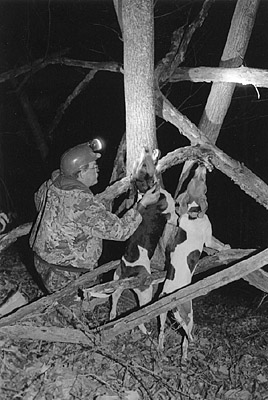
Jerry hunts his dogs every night. Here he praises Knothead and a trainee who have just treed a coon. Photo by Michael Keller
Coondog Heaven
By John Blisard
Photographs by Michael Keller
When I arrived at the gate of Shaffer's Kennels for my first visit, I saw 12 or so coondogs, 25 deer, and a flock of Canada geese. The dogs barked in a friendly way at my arrival, but to my surprise, they showed no interest in the nearby deer or the fowl.I soon learned that this 100-acre compound in rural Kanawha County, protected by two miles of fence, is in a different world. Here, coondogs from across the country - as many as 50 at a time - revel in ideal surroundings, under the watchful and loving care of dog trainers Jerry and Yvonne Shaffer. These hounds are here for an advanced education in trailing and treeing raccoons, and the Shaffers' finely honed teaching methods keep the dogs' attention focused on their intended game, and away from all distractions.
Coondogs have been an important part of the hunting scene here in West Virginia for generations, going back to the colonial period. In an earlier day, the hunting skills of mountain people were essential to their survival, and a good dog was as important to them as a straight-shooting rifle. As recently as 25 years ago, raccoons were considered valuable for their fur; some hunters still eat the meat.
More often today, however, hunters and their dogs enjoy the sport of trailing and treeing raccoons for the sheer pleasure of it: the enjoyment of being in the woods in the dead of night, and the satisfaction of shining a light high into a tree and seeing the reflection of two small eyes peering back. An increasingly popular pastime in recent years has been participation in organized competition hunting, where dogs earn points, prizes, and prestigious titles and trophies for their hunting skills.
Here at the head of Coopers Creek, Jerry and Yvonne Shaffer are training some of the top coondogs in the nation.
You can read the rest of this article in the Winter 2000 issue of Goldenseal, available in bookstores, libraries or direct from Goldenseal.